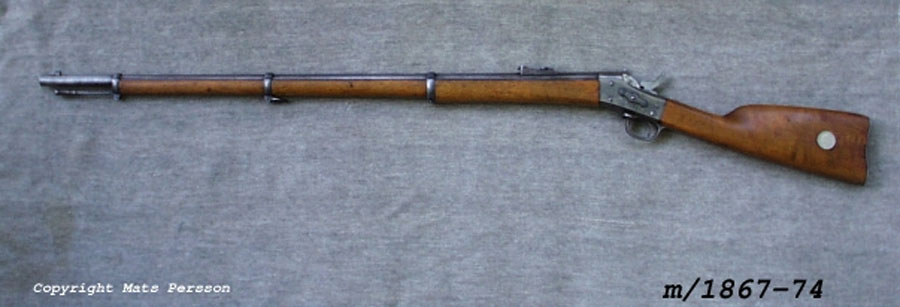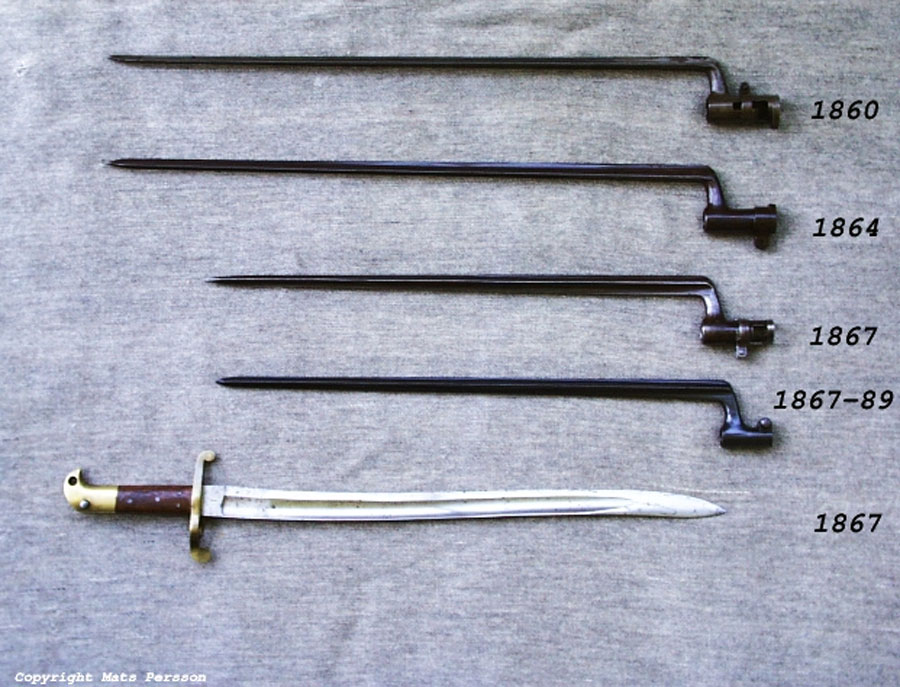

Text Mats Persson
In 1864 Sweden adopted a chamber loaded rifle designed by A. Hagström. About
16 000 were made but apparently they never entered service before the new
Rolling-block rifle was adopted on May 8, 1867.
Most of the chamber loaded rifles of 1864 were converted to Rolling-block rifles,
designated 1864-68 års gevär (or gevär m/1864-68).
Beginning in 1885 most of these rifles were shortened and are now known as
1864-68-85 års karbin (or karbin m/1864-68-85).
| 1886 | 8135 |
| 1887 | 1470 |
The m/64-68-85 carbine used the same rim-fire cartridge with a copper case,
as all Swedish Rolling-block rifles in the 12,17 mm calibre.
Most of the existing rifles, as well as carbines, have been converted by
civilian shooters to fire centre-fire ammunition in the same calibre - called
the 12,7×44R.
In 1871 Husqvarna made 984 carbines with the Remington No 1½
Rolling-block action and a full length front stock.
No sling-swivels, but a saddle-ring on the left side of the receiver.
The receiver is somewhat more narrow than the action on the 1867 rifle.
In 1877 Husqvarna produced another 2000 weapons, and Carl Gustaf
made 2460. In 1878 Carl Gustaf delivered 1540 more.
All to all 6984 weapons.
In 1880, 4178 of the 1870 carbines were revised by Carl Gustaf, the next year the remaining 2806 went through the same proces.
Between 1877 and 1879 Husqvarna also manufactured the 1870 carbine for the civilian market, called the "Remingtongevär Nr. 9".

The Remington Rolling Block rifle was adopted by Sweden on the 8th of May,
1867.
The first ten thousand rifles were made by Remington, who also made twenty
thousand actions that were partly used for the Husqvarna rifles.
Read about the correct designations as per 1880.
The 1867 rifles used either the
1867 socket
bayonet or the
1867 sword
bayonet.
All true 1867 rifles had a bayonet lug on the right hand side of the barrel.
All converted rifles used their original bayonet - either the 1860 socket
bayonet or the
1864 socket
bayonet.
None of the converted rifles used the sword bayonet.

The 1867 rifle used a rim-fire cartridge with a copper case, called the Kaliber 410 (12,17×42R). The land-to-land diameter of the bore was 0,41 Swedish inches or 12,17 millimetres (.48 Imperial inches). The case length was 1,4 Swedish inches. The diameter of the bullet was 12,61 millimetres. The twist of the groves was one turn in 78 calibres.
Some rifles were altered by civilian shooters so that they could use
centre-fire ammunition in the same calibre, for some strange reason called the
12,7×44R.
By using centre-fire cartridges they where able to use reloadable brass cases,
which reduced the costs for ammunition considerably. Centre-fire cases also
allowed the shooters to use stronger loads than a rim-fire case would handle.
Because the civilian 12,7×44R used a bullet with almost the same diameter as the
bullet of the 12,17×42R the only modification needed was a new block.
Since one had to use military rim-fire ammunition in some matches most
civilian shooters carried two blocks, one for rim-fire and one for centre-fire
ammunition.
On most of the existing 1867 rifles one can see that the block has been
converted to civilian centre-fire ammunition.
The very first rifles are said to have had a kind of bow-sight. But few of
these sights are known and it is uncertain if issued rifles ever had this kind
of sights.
The ordinary rifles had a ramp-sight with two sight-notches (over and under).
The sight was graduated in Swedish feet (0,297 m), from 800 to 1400 (8,10,12,14)
- using the upper notch.
The lower notch was used at a distance of 400 feet, with the slide in the 800
feet position.
In the flipped up position the sight was graduated in 1600, 1800 and 2000 feet.
Beginning in 1879 the sights on all 1867 rifles were modified. The upper notch was cut away and the sight was re-graduated in metres - 120,180,240 and 300. Flipped up, and using the sight notch on the slide, it was graduated from 350 to 750 metres. On the top of the sight-ladder is the 900 metres notch.
Rifles and locks made by Remington were marked "REMINGTONS ILION N.Y. U.S.A." (and the patent numbers) on the upper action tang.
Rifles made in Sweden were stamped with the manufacturer on the right hand
side of the receiver and on the top of the barrel.
Rifles stamped with a crowned C are made by Carl Gustafs stads
gevärsfaktori.
Rifles stamped with an H are made by Husqvarna vapenfabriks AB.
Rifles stamped with an S surmounted by the old type open crown are
made by Stockholms gevärsverkstad.
Rifles stamped Cb surmounted by the old type open crown are made by
Carlsborgs Tygstation.
The year of manufacture was stamped on the right hand side of receiver and stock, and on the bottom side of the barrel.
The signatures of the inspection officers were stamped on the left hand side of the receiver, on the top and the right hand side of the barrel.
The serialnumber is stamped on the left hand side of the receiver, the
barrel, the front stock and the butt stock as well as on the butt plate.
The serialnumber could also be found on the left hand side of the trigger
assembly, but on some weapons one would have to remove the buttstock to see it.
Just a very few rifles and carbines assembled by officers attending the
Armourer-course are marked with the name of that pupil in block letters - and
nothing else.
These weapons belonged to the officer and never entered military service.
Remington sold 10 000 rifles and 20 000 actions to the Swedish army. The 20 000 actions were used for locally produced rifles.
Made most of the Swedish Rolling Block rifles.
Somewhere around 100 000 to 120 000 rifles and 4000 carbines.
Husqvarna made some 80 000 rifles and 2984 carbines, all in.
Stockholms gevärsverkstad and Carlsborgs Tygstation were no rifle factories but army workshops or armouries. Hence, they only made a few weapons.
| Year | Rifles | Carbines | |||
| Husqvarna | Carl Gustaf | Total | Husqvarna | Carl Gustaf | |
|---|---|---|---|---|---|
| 1867 | 3835 | - | - | ||
| 1868 | 2004 | - | - | ||
| 1869 | 5592 | - | - | ||
| 1870 | 10290 | - | - | ||
| 1871 | 12174 | 984 | - | ||
| 1872 | 18311 | 35000 | - | - | |
| 1873 | 15516 | - | - | ||
| 1874 | 8649 | - | - | ||
| 1875 | 2269 | 20287 [2] | - | - | |
| 1876 | na [1] | 10737 | - | - | |
| 1877 | na [1] | 2327 | 2000 | 2460 | |
| 1878 | - | - | - | - | 1540 |
| 1879 | - | - | - | - | - |
| 1880 | - | - | - | - | - |
[1] There are no figures for Husqvarna in 1876 or 1877, but the production
volume in 1876 ought to be somewhat lower than in 1875. In 1877 military orders
dropped to almost nothing except for the 2000 carbines.
[2] 632 m/67-68 rifles and 19655 m/67-74 rifles.
Husqvarna sold the 1867 rifle as the "Remingtongevär Nr 7" to civilian shooters and shooting associations. These rifles are similar to the service rifles but lack the inspection signatures.
Husqvarna also made numerous models of hunting rifle using the Rolling-block
action.
As far as I know these weapons only have "Husqvarna" and the serial number on
the barrel - no markings on the action.
Gunsmiths at Carl Gustaf could buy discarded parts at a low price. These were
then used to manufacture hunting rifles in private workshops. These rifles are
normally marked with the name of the gunsmith.
The fact that these weapons are made from parts rejected by the army inspectors
does not in any way mean that they were of a sub-standard. The main reason why
parts were discarded by the army was that they were out of tolerance - but a
civilian gunsmith, that did not have to bother about the different parts
interchangeability between guns, could easily make such a discarded part fit in
to a new rifle.
In 1877 Carl Gustaf made 277 hunting rifles. This seems to have been a one time event.
On the very same day as Sweden, Norway adopted a similar rifle and ammunition.
Differences:
Husqvarna manufactured 6 000 of the Norwegian rifles. As far as I know Kongsberg in Norway made all the rest (until 1876 they had manufactured 24 000 rifles).
Also Denmark adopted a Rolling-block Rifle in 1867.
The Danish rifle of 1867 is quite similar to the Swedish 1867 rifle of the
type made in America.
The Danes used rimfire ammunition of cal 11,44 mm.
Differences:
The Danish rifles are either made by Remington Ilion USA, or by the
Amager branch of the Copenhagen Armoury "Københavns Tøjhus".
The name of the manufacturer can be found on the upper action tang, the serial
number is stamped on the left hand side of the barrel.
Remington delivered 30 000 rifles and 1 800 carbines in 1868.
As far as I know Københavns Tøjhus made the rest of the Danish rifles.
Beginning in 1868 Kronborg in Helsingør made 1 600 carbines for the
Danish Engineers and Cavalry reserve.
In 1876 the Swedish Army estimated that Denmark had 42 500 rifles and 3 400 carbines with the rolling block action in inventory.
© Copyright Mats Persson 2000
Mats Persson 1998-05-22